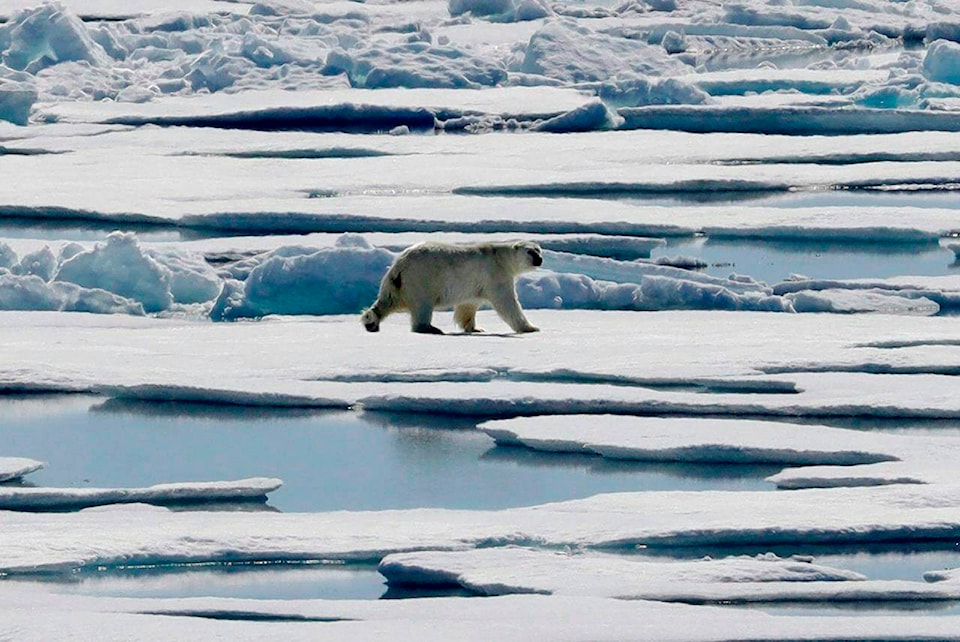MONTREAL — It was necessary to shoot dead instead of relocate a polar bear found wandering on Quebec’s Gaspé peninsula over the weekend, wildlife experts said Monday.
Government officials didn’t have the proper equipment or the tranquillizers needed to handle the 650-pound animal, Sylvain Marois with Quebec’s Wildlife Department said in an interview.
“We are equipped for black bears, moose … but a polar bear, that’s double the size of a black bear,” Marois said.
The bear was killed to ensure public safety, he said, after it was spotted in a wooded area Saturday near the town of Madeleine-Centre, Que., located about 580 kilometres northeast of Quebec City, on the south shore of the St. Lawrence River.
Wildlife officials say they don’t know where the bear came from, but Ian Stirling, one of the world’s foremost polar bear experts and adjunct professor at the University of Alberta’s department of biological sciences, said the bear’s large size suggests it had been feeding around the South Labrador Sea, where food is abundant.
“There’s only one place where it could be that fat this early,” Stirling said in an interview Monday. “Anywhere else in the Arctic, they are usually a little bit on the thin side — but this one was very fat.”
He said the bear most likely ended up in Gaspé by swimming to the peninsula or floating south on a piece of ice from Newfoundland. It’s very normal, Stirling explained, for polar bears, especially males, to wander and explore.
“Though not many bears find their way out to the unstable edge of the pack ice, those that do find their way into that general area feed very well and put on a lot of weight in a short time,” he said.
“When the ice breaks up and the harp seals go to sea again, most of the bears go back north along the coast of Labrador, on the nearshore ice and spend the summer (open water) season there,” Stirling said. “However, some, often subadult males haven’t gotten their directions straight yet, or maybe just wander around.”
Prof. Andrew Derocher, also with the University of Alberta’s biological sciences department, is currently in Churchill, Man., doing fieldwork on polar bears. He said the bears “really don’t belong in Gaspé.”
“People are very much in love with polar bears,” Derocher said Monday in an interview. “It comes back to this idea of beauty and the beast. They are beautiful to look at, but they are incredibly frightening. And because they are so far away, you can focus on the beauty. But when all of the sudden it’s in your backyard, then it becomes the beast and it’s no longer welcome.”
He said it is standard procedure to kill polar bears that wander into regions unused to them.
“Knowing what the wildlife officer has for equipment and the logistic of this … you have to get the bear, immobilize it until you get a cage strong enough to hold it and put it on a plane to fly it somewhere in Labrador and then let it go … it would have been a very expensive operation,” Derocher said.
Derocher, however, said the cost of relocating a bear shouldn’t be the only concern, adding that killing a polar bear, from a population conservation perspective, is never ideal.
Canadian polar bears, which make up two-thirds of the world’s total estimated population, are listed as vulnerable species in Quebec and Newfoundland and Labrador.
“The habitat is disappearing,” Derocher said. “What’s happening is that the sea ice is not as robust as it has been; animals get broken off, drift away from where they want to be. We are seeing these random events occurring across the range of polar bears.”
This report by The Canadian Press was first published on May 2, 2022.
—-
This story was produced with the financial assistance of the Meta and Canadian Press News Fellowship.
Virginie Ann, The Canadian Press
